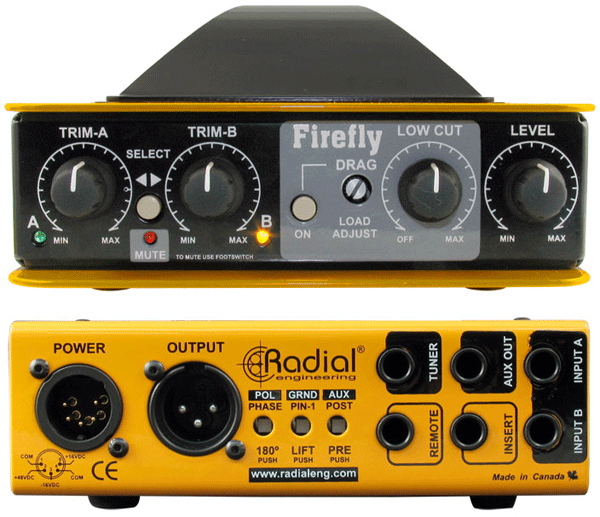
|
|
Radial Engineering Firefly Tube Direct Box-- Front and Back |
Finally, an important recessed switch changes the 1/4-inch Aux/Thru signal chain completely. When Pre is selected, the buffered feed from your instrument is passed on to your stage/studio amp--a direct box thru. When Post is selected, the final sound of the Firefly includes the tube stage HPF, and insert loop effect as the main XLR output is "mirrored" on the Aux/Thru jack--tube preamp mode.
To avoid a ground loop, I plugged both the amp and Firefly into the same AC wall socket. On powering up, the unit mutes for about 45 seconds while the tube stabilizes. I set the Aux/Thru switch to Pre and switched Drag off. The buffered signal of my stock Fender Strat went to my Fender Blues Junior out in the studio and the Firefly's XLR output was recorded using my Sunset Sound S1P mic preamp. The sound was clean, clear and with no hum or noise--exactly as my Strat sounds.
I found the buffered output sent to the amp using a 25-foot cord to have the same sparkle and life as when using a short cord straight out of the guitar.
The fun started when I set the Aux/Thru path to Post. The entire sound of Firefly is available for both the amp and the XLR connector at the same time. I found this especially good for direct guitar and bass recordings. It was easy to add some "hair" to overly clean bass sounds; and for guitar, the Firefly offered a new shade of coloration as a tube preamp in front of the guitar amp itself.
In Post mode, all Firefly settings including the Level control affect both the amp's volume and the record level. By cranking up the gain on an input and throttling back the Level control, I could hear the strong saturated sound of the 12AX7 coming into play.
I experimented with the Drag control. Drag does not affect instruments with active electronics, but it does affect the way instruments with passive pickups feel, play and sound. For a direct guitar overdub I started with Drag at the extreme, all the way counter-clockwise at 22k ohms. This produced a very thick, sluggish-responding "dead" and rolled-off sound with no sustain at all! While my guitar player perfected the part for the song, I slowly turned the Drag's screwdriver adjustment clockwise to partially unload the pickups and restored just the right amount of brightness. Even though Drag is a fiddly screwdriver control, I found both it and the HPF to be useful musical controls in the studio.
Firefly is a great utility piece of studio kit for musicians, studios and FOH engineers to have on hand. It is rugged and fully adaptable to any situation in a studio session or onstage. Recommended!
 |
Try This! |
 |
|
The Tuner output of Firefly is always on, so use it to drive an effects pedal or a secondary guitar amp without affecting Firefly's operation.
--
Barry Rudolph |
|
 |
|
 | | |
|
 |
Radial Engineering |
 |
|
Web Site: www.radialeng.com
Product: Firefly Tube Direct Box
Price: $599 MSRP
Pros: A worthwhile, flexible piece of musical equipment for studio and stage.
Cons: Some of the controls and switches are not easily accessible. |
|
 |
|
 |
| |
Barry Rudolph is an L.A.-based recording engineer. Visit his Web site at:
WWW.BARRYRUDOLPH.COM
|
